Fate-ful Stories, Part 2
Last week, I started telling card-by-card design stories about Fate Reforged. I got to J. That means today is the rest of the alphabet (although I'm skipping ahead to L).
Lightning Shrieker
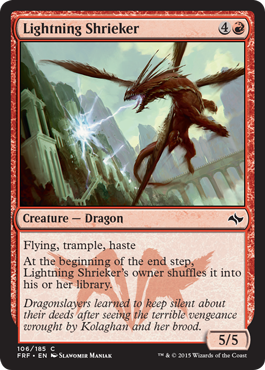
We're in a world where dragons are once again alive. That means there has to be a decent number of Dragons. Rare has a multicolor cycle. Uncommon has a monocolored cycle. But there was one thing left to make. Dragons are red's iconic creature so we wanted to make sure that Dragons felt a little more red than any other color. To do this, we made one red common Dragon. This might not be a lot in number but being the only common Dragon would mean it would be seen a lot more than any other Dragon.
The next big challenge was how to make a common Dragon. You want it to feel dragon-y enough that it's clearly a Dragon but you want it to also make sense as a common. Traditionally, red doesn't get 5/5 creature at common, and seldom ones that fly. The answer was in thinking of it more like a direct damage spell than a creature. By giving it haste and sacrificing it at end of turn, it got to have the body of a dragon but fit in the Lava Axe slot at common.
Marang River Prowler
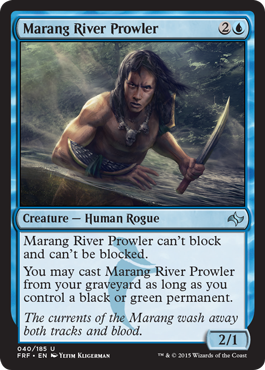
The Runemarks were a cycle of Auras that got better if you controlled a permanent of one of two other colors. Marang River Prowler is from an uncommon cycle that goes in a different direction (activation-wise, that is). Jeskai Runemark, for instance, was a Jeskai card put into Jeskai's center color. While Marang River Prowler is also mono-blue, it is not a Jeskai card but a Sultai one.
Another difference from the Runemark cycle is that the ability gained by the card is not in-color but something both the other colors can do. As an example, blue cannot get its creatures back from the graveyard and onto the battlefield, but it's something black and green can do.
Palace Siege
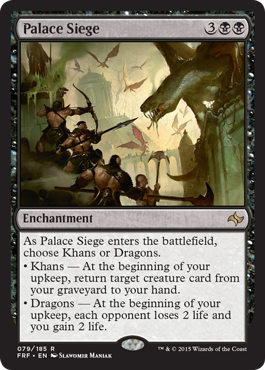
Other than Crux of Fate, there are five other cards that make you choose between Khans and Dragons when casting them. These five cards are a rare cycle called the Sieges. They are all enchantments that have an effect each turn. That effect is determined when you first play the card. The idea behind the design is that each effect is very different from the other on the card to give you some versatility when playing it.
Let's take Palace Siege as the example. One effect allows you to keep putting creature cards from your graveyard into your hand while the other effect is draining your opponent for 2 life each turn. What choice you make sure varies depending on the situation you find yourself in.
The fun part of this cycle was making sure that one ability felt more Khan-ish and the other more Dragon-ish. On Palace Siege, the khans keep getting more reinforcements for the attack while the dragons get to keep directly hurting the opponent.
Renowned Weaponsmith
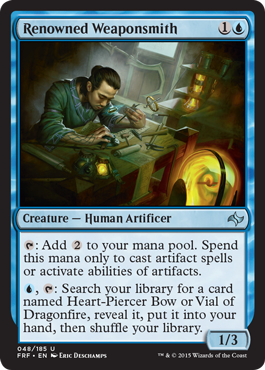
Renowned Weaponsmith plays into the artificer aspect of blue. This card is part of blue's ability to produce colorless mana used to cast and activate artifacts. We are back in the past and get to meet a weaponsmith known for his fine craftsmanship. In fact, his Heart-Piercer Bow will survive long after he has died. But what is this Vial of Dragonfire that he makes?
Shu Yun, the Silent Tempest
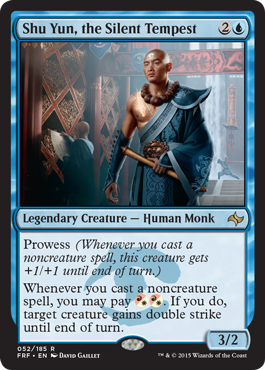
Shu Yun was our legendary creature from the Jeskai clan. That meant he had to be base blue with a red/white activated or triggered ability. This design was one of the easier ones. We started by giving the base creature prowess. This was the Jeskai ability from Khans of Tarkir that was also around 1,000 years ago in Fate Reforged. Prowess triggers off of a noncreature spell being cast. It would be very easy to make the red/white ability work off of the same trigger. The only question is what should it do?
Red and white overlap in two related creature abilities, first strike and double strike. As prowess is all about power (and toughness) pumping in combat , both strikes were a good fit. As this was a splashy legendary creature we opted to go with double strike. Mixed together, they created a very Jeskai-feeling card, one that had the potential to be a great fighter, but when such a change would happen was a mystery to the opponent. As long as you had some mana and one card, Shu Yun could deal 8 damage, 4 of which would be first strike.
Soul Summons
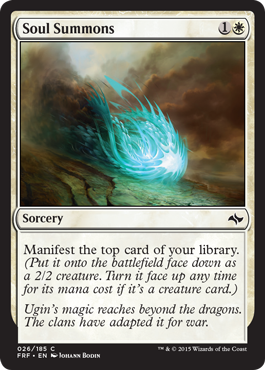
As I explained in my first Fate Reforged preview column, manifest was designed during exploratory design (and was originally called recruit). Soul Summons was the first manifest card made. It was what I think of as the vanilla manifest card. It does what the effect does in the simplest possible way. Back in exploratory design, manifest merely put the card into play; it didn't grant any ability to turn it face-up, so this card originally just made a face-down 2/2 that could only turn into something if you happen to hit a morph creature.
Soulflayer
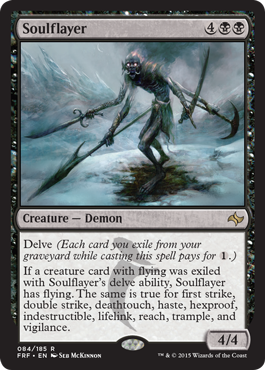
Part of the fun of continuing a mechanic in the second set is you get to further play around in the design space of the mechanic. Soulflayer not only has delve but cares about what cards were delved away. This completely changes how you build your deck because you care about which cards you get into your graveyard. If delve ever returns, this is an area we could mess around in a little more.
Tasigur, the Golden Fang

Tasigur is the Sultai character of the legendary creature cycle. This means he needs to be base black with a green/blue activated or triggered ability. The base black ability seemed obvious, delve, the Sultai mechanic from Khans of Tarkir that was also in Fate Reforged. The green/blue ability proved a lot harder.
Green and blue's overlap is not a giant one. Both have flash and hexproof but neither of those fit Sultai well. They both overlap in card drawing but black is secondary in card drawing with green so it didn't quite have the right feel. The Sultai is very graveyard focused, so the design wanted the graveyard to matter in some way. The card already had delve, so if the graveyard mechanic could somehow work with delve, that would be preferred.
All five colors have some ability to get cards back from the graveyard, with green being the best color at it. Likewise, all the colors have some limited ability to self-mill, with blue being the best at that. What if we took something green was very good at that blue was okay at and something blue was very good at that green was okay at and combine them?
Adding cards to the graveyard was the way to interact positively with delve, so that seemed like an obvious choice. Blue self-mills without limits while green usually self-mills while looking for things in its library, often creature or lands. That effect leaned toward blue. Green's best interaction with the graveyard is either caring about what is in it or getting things back from it. Blue gets back instants and sorceries and on rare occasions a few other things. What if the second ability let you get a card back from your graveyard? Because blue's not great at it, take the decision out of the hands of Tasigur's controller. Let the opponent decide. The reason this is extra fun is that it allows the delve that Sultai plays to matter because you can eat away the cards you don't want, forcing the hand of the opponent.
The activated ability is definitely an odd one but hybrid designs often force us to search into the nooks and crannies of design space. The synergy and flavor, though, was strong enough for us to make the call.
Temporal Trespass
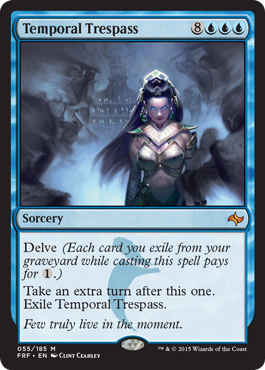
When we made Treasure Cruise, I got asked a lot if we'd make any other Power Nine cards with delve. The number one card people asked me about was Time Walk. You can't cast this ever for 1U but UUU is kind of close.
Ugin, the Spirit Dragon
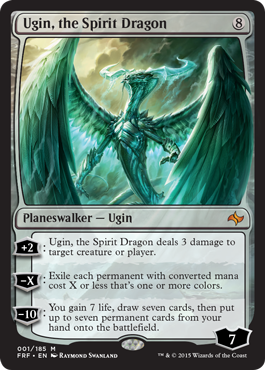
When the creative team chose to make the time-travel story about Sarkhan and his home plane of Tarkir, it was instantly obvious that Ugin was going to be somehow involved. Sarkhan was already hearing voices, which was known by the creative team to be Ugin. What exactly was Ugin up to? The creative team also figured out it wanted Sarkhan traveling back significantly in time, which meant that any modern-day character who was there would have to be pretty old, like say an ancient colorless dragon. Also, as the shtick of Tarkir was that Sarkhan was going to try and bring back the dragons that had all died, involving a dragon in the process was ideal.
Remember that although Ugin is a known quantity in the Magic story, we had never actually met him before. His first appearance was a short story written in connection to this block. Having him play a major role in the story meant that we were going to have to make him a card, and as he's a Planeswalker, that meant Magic was going to get its second colorless Planeswalker. (Karn Liberated says hi.) This brought up all sorts of questions.
#1—Pre-Mending Planeswalkers
Back in the day, Magic had a problem with our Planeswalkers—they were über powerful, essentially gods. Telling stories about gods is difficult. So in Time Spiral block, the creative team created an event called the Mending that completely changed the nature of Planeswalkers. Now, rather than beings with infinite power, they were mages whose only common bond was the ability to walk between planes. They were mortal and much better sources for good stories.
The issue is that Fate Reforged takes place more than a thousand years ago, clearly before the Mending. That meant that any Planeswalker native to this time would be a pre-Mending Planeswalker. The reason we never made Planeswalker cards prior to the Mending was partly because we felt they were too powerful to be represented by cards. How exactly were we going to make Ugin in a satisfying way on a card?
The problem, interestingly enough, was not even solved by the Fate Reforged design team, but rather by the design team of Commander (2014 Edition). They were making Planeswalkers that could serve as commanders and ended up wanting to turn some pre-Mending Planeswalkers into cards. After some discussion, it was decided that the Planeswalker card does not represent the full power of the Planeswalker, but rather the amount that the Planeswalker is willing to help out the mage who asked for help.
With this idea in mind, the Commander (2014 Edition) design team went ahead with its Planeswalkers. We took the same basic strategy. The one thing we did know, though, was that we still wanted Ugin to feel very powerful. To accomplish this, we chose to have him have a high converted mana cost. That allowed us to make him very powerful with a strong ultimate.

Ugin, the Spirit Dragon | Art by Raymond Swanland
#2—Ugin Was Dead
For those who read my blog, whenever someone asks us to bring back a dead character, I always say that in Magic, "dead is dead." What I mean by that is we want our character deaths to mean something, so we've been very careful about keeping characters dead once they die. We want characters that "die on stage" to stay dead. Ugin, though, didn't die on stage. In fact, the only thing we knew about the fate of Ugin was one reference by Nicol Bolas where he claims in vague terms to have killed him. We didn't see Bolas kill him. All that was known is that Bolas claimed to have done it.
As the creative team was setting up the story, it realized that this would be the perfect opportunity to capitalize on Bolas's claim. What if Bolas was telling the truth? Sarkhan's trip back in time could be to save Ugin. That felt epic and it tied into the larger story in a very cool way. So why is it okay that we're bringing back a dead character if we don't normally do that? For starters, Ugin wasn't really even dead until we stated that he was. Bolas's claim was hardly definitive. He's a known liar and the fate of Ugin has been much debated. Finally, announcing he is dead during the story where he's coming back from death is very different from undoing an "on stage" death from another story.
#3—What Part of the Pie Is Colorless
I've written many, many words about the color pie and the role the five colors play in it. I even wrote an article once about the color pie of artifacts. I have never written anything about the color pie of colorlessness, though. On some level, nothing is off limits, but at the same time, the card didn't want to read as fitting in a specific color. Getting this balance would be tricky.
Okay, let's look at what the card actually does.

The plus ability is the card Ghostfire (from Future Sight). That card, in its flavor text, tied itself to Ugin, and the colorlessness helps make it feel like a colorless effect.

What is Ugin most famous for? He, along with Sorin and Nahiri (aka the Lithomancer), locked away the Eldrazi on Zendikar (which, by the way, for all the conspiracy theorists out there, is not the same plane as Tarkir). This first minus ability ties into that flavor.

The other thing that Ugin is famous for and is a key part of Fate Reforged is his classic battle with Nicol Bolas. How do you show that Ugin is the yin to Bolas's yang? How about an ultimate that does the exact opposite (well, really close) to the ultimate on Bolas's Planeswalker card?
When you add all the abilities together—direct damage, exiling permanents, gaining life, drawing cards, and putting permanents into play—you get effects that run the gamut of colors, allowing this card to not feel like it belongs in one or two colors.
I should stress that design took many stabs at the design of this card but that the majority of the work on it, as is the case with most Planeswalkers, happened in development. I'm very happy with how the card ended up and development feels like the card has a strong chance at being played at the highest level of play.
And that, my faithful readers, is how you make an ancient colorless dragon Planeswalker.
Warden of the First Tree
Sometimes you venture into virgin territory and make cards like nothing anyone has seen before and sometimes you take something that was popular and do it again. Warden of the First Tree is the latter. This card was inspired by this card:
Figure of Destiny was the most popular card from Eventide. In addition, it was the card that was the inspiration for the level-up mechanic in Rise of the Eldrazi. (Brian Tinsman was responsible for both.) As we were messing around with hybrid activations, Figure of Destiny popped to mind. Yes, Figure of Destiny had a hybrid mana cost as well, but the idea could be easily shifted over. Both cards start as a one-mana 1/1 and then grow from there. The growth rate wasn't the same and the activations weren't identical, but the template was strong enough to make a related yet different card, one that dipped into three colors rather than two.
Wardscale Dragon, Mindscour Dragon, Noxious Dragon, Shockmaw Dragon, Destructor Dragon

We're back in the time of dragons. Rare got its cycle of legendary Dragons that embody the dragon attributes. Red got its common to make sure Dragons feel a bit more red than any other color. What remained was to make a cycle that would make sure the presence of Dragons was felt in Limited. That meant we had to do that at uncommon.
The trick to this cycle was to make them feel connected but not too repetitive. After some discussion, the decision was reached that they would each be a 4/4 flier for six mana, two of which would be colored. That was enough of a connection, so each would get an ability that it could use to feel flavorful to the color it's in. Of all the Dragons in the set, this cycle was actually the hardest, as it had to straddle the line between being good enough for it to have an impact on Limited but not so good that it dominated. The development team, led by Dave Humpherys, worked very hard to make this happen.
Yasova Dragonclaw

Now we come to the last of the legendary creature cycle, this time the Temur one. Yasova needed to have a green body and a blue/red activated or triggered ability. A 4/2 body for 2G seemed to be a good start for the former. Note that she has 4 power so she triggers the ferocious ability that the Temur use in both Khans of Tarkir and Fate Reforged.
The hard part was finding a blue/red ability that played nicely with the green body. Blue and red are tricky because they are two of the colors with the least amount of mechanical overlap. One area they do overlap in, though, is stealing the opponent's creatures. Blue normally steals them permanently while red steals them temporarily. Once upon a time, blue did both, but we moved off the temporarily stealing to give red a little more to do. It is flavored as red's ability to make others act impulsively and plays into its trickster nature.
As temporarily stealing is the weaker of the two abilities, the overlap of the ability rests there. The one other issue to deal with was making sure that the overall card felt Temur. To help with this, the blue/red ability was limited to stealing things that had a power that was smaller than Yasova's power. That plays into the power-matters theme seen in Temur, including in its mechanic ferocious. To steal bigger things, you have to make Yasova bigger.
Laying the Cards on the Table
And that finishes up my jaunt through the card-by-card design stories from Fate Reforged. I hope you enjoyed the different behind-the-scene peeks. As always, I'm interested in any feedback you may have. You can contact me through my email or any of my social media (Twitter, Tumblr, Google+, and Instagram).
Join me next week when we'll see if I can find the time.
Until then, may you use the Fate Reforged cards to make some stories of your own.
"Drive to Work #192 – Scourge, Part 1”
“Drive to Work #193 – Scourge, Part 2”
This week we have the first two parts (of a four-part series) on the design of Scourge, the final set in the Onslaught block.
- Episode 193 Scourge, Pt. 2 (14.8 MB)
- Episode 192 Scourge, Pt. 1 (14.4 MB)
- Episode 191 : World Building (13.4 MB)
- Episode 190 : Card Being Made (15.2 MB)
- Episode 189 10 Things Rules (15.2 MB)
- Complete Drive To Work Podcast Archive

